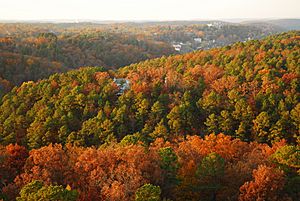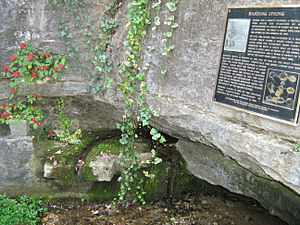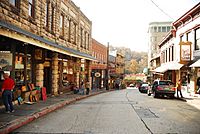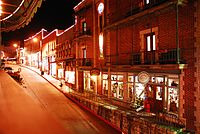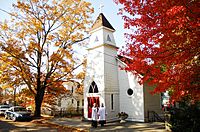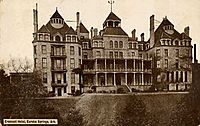Eureka Springs, Arkansas facts for kids
Quick facts for kids
Eureka Springs, Arkansas
|
|
|---|---|
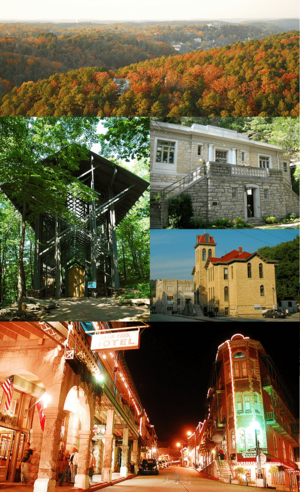
Clockwise, from top: aerial view of Eureka Springs, Eureka Springs Public Library, Carroll County Courthouse, Commercial Historic District at night, Thorncrown Chapel
|
|
| Nicknames:
"Eureka", "Little Switzerland of America", "The Stairstep Town"
|
|
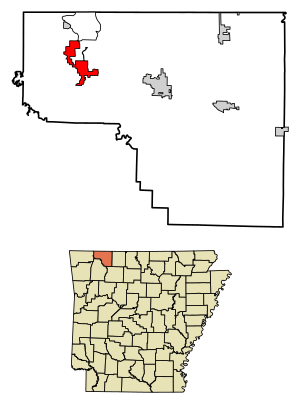
Location within Carroll County and Arkansas
|
|
| Country | United States |
| State | Arkansas |
| County | Carroll |
| Incorporated | 1880 |
| Government | |
| • Type | Mayor–council government |
| Area | |
| • Total | 6.90 sq mi (17.86 km2) |
| • Land | 6.76 sq mi (17.50 km2) |
| • Water | 0.14 sq mi (0.36 km2) |
| Elevation | 1,260 ft (380 m) |
| Population
(2020)
|
|
| • Total | 2,166 |
| • Density | 320.51/sq mi (123.75/km2) |
| Time zone | UTC−6 (CST) |
| • Summer (DST) | UTC−5 (CDT) |
| ZIP Codes |
72631, 72632
|
| Area code | 479 |
| FIPS code | 05-22240 |
| GNIS ID | 0048926 |
Eureka Springs is a city in Carroll County, Arkansas, United States, and one of two county seats for the county. It is located in the Ozarks of northwest Arkansas. As of the 2020 census, the city population was 2,166.
The entire city is on the National Register of Historic Places as the Eureka Springs Historic District. Eureka Springs has been selected as one of America's Distinctive Destinations by the National Trust for Historic Preservation. Eureka Springs was originally called "The Magic City" and later the "Stairstep Town" because of its mountainous terrain and the winding, up-and-down paths of its streets and walkways.
It is a tourist destination for its unique character as a Victorian resort village. The city has steep winding streets filled with Victorian-style cottages and manors. The historic commercial downtown of the city has an extensive streetscape of well-preserved Victorian buildings. The buildings are primarily constructed of local stone, built along streets that curve around the hills and rise and fall with the topography in a five-mile long loop. Some buildings have street-level entrances on more than one floor and other such oddities: the Basin Park Hotel has its front entrances on the floor below first, and a ground-level emergency exit in the back of the building on the fifth floor. The streets wind around the town, with few intersecting at right angles. There are no traffic lights.
Contents
History
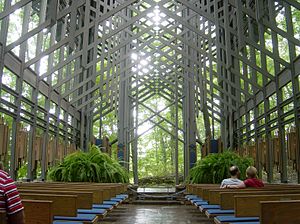
19th century
Native American legends tell of a Great Healing Spring in the Eureka Springs area. People of various indigenous cultures long visited the springs for this sacred purpose.
The European Americans also believed that the springs had healing powers. After the Europeans arrived, they described the waters of the springs as having magical powers. Dr. Alvah Jackson was credited in American history with locating the spring, and in 1856 claimed that the waters of Basin Spring had cured his eye ailments. Dr. Jackson established a hospital in a local cave during the Civil War and used the waters from Basin Spring to treat his patients. After the war, Jackson marketed the spring waters as "Dr. Jackson's Eye Water".
In 1879 Judge J.B. Saunders, a friend of Jackson, claimed that his crippling disease was cured by the spring waters. Saunders started promoting Eureka Springs to friends and family members across the state and created a boomtown. Within a period of little more than one year, the city expanded from a rural spa village to a major city. Within a short time in the late nineteenth century, Eureka Springs developed as a flourishing city, spa, and tourist destination.
On February 14, 1880, Eureka Springs was incorporated as a city. Thousands of visitors came to the springs based on Saunders' promotion and covered the area with tents and shanties. In 1881, Eureka Springs enjoyed the status of Arkansas's fourth largest city, and by 1889 it had become the second largest city, behind Little Rock.
After his term as a Reconstruction governor, Powell Clayton moved to the heavily Unionist Eureka Springs and began promoting the city and its commercial interests. Clayton promoted the town as a retirement community for the wealthy. Eureka Springs soon became known for gracious living and a wealthy lifestyle.
In 1882, the Eureka Improvement Company was formed to attract a railroad to the city. With the completion of the railroad, Eureka Springs established itself as a vacation resort. In only two years, thousands of homes and commercial enterprises were constructed. The Crescent Hotel was built in 1886 and the Basin Park Hotel in 1905. These many Victorian buildings have been well preserved, forming a coherent street scape that has been recognized for its quality. In 1892, the New Orleans Hotel and Spa was built along Spring Street and is now operating as an all-suite hotel full of Victorian furniture and art.
20th century
The Ozarka Water Company was later formed in Eureka Springs in 1905. Carrie Nation moved here towards the end of her life, founding Hatchet Hall on Steele Street. The building was later operated as a museum, but is now closed.
The only bank robbery to occur in Eureka Springs was on September 27, 1922, when five outlaws from Oklahoma tried to rob the First National Bank. Three of the men were killed and the other two wounded.
In 1950 Opera in the Ozarks at Inspiration Point was founded. The organization continues to present an annual summer opera festival in Eureka Springs. In 1967, the famous 7-story Christ of the Ozarks Statue was built. A year later, The Great Passion Play was begun as an outdoor performance piece. It is regularly performed from May through October by a cast of 170 actors and dozens of live animals. It has been seen by an estimated 7.7 million people, which makes it the largest-attended outdoor drama in the United States, according to the Institute of Outdoor Theatre of the University of East Carolina at Greenville, North Carolina. Christian-themed attractions have been added in association with the drama production. These include a New Holy Land Tour, featuring a full-scale re-creation of the Tabernacle in the Wilderness; a section of the Berlin Wall; and a Bible Museum featuring more than 6,000 Bibles. (Items include an original 1611 King James Bible, a leaf from a Gutenberg Bible, and the only Bible signed by all of the original founders of the Gideons.)
In 1980, the architect E. Fay Jones designed Thorncrown Chapel. In 2006, it was selected for the "Twenty-five Year Award" by the American Institute of Architects, which recognizes structures that have had significant influence on the profession. Because of the special nature and quality of its architecture, the chapel was listed on the National Register of Historic Places in 2000.
21st century
On May 10, 2014, Eureka Springs became the first city in Arkansas to issue marriage licenses to same-sex couples. On May 12, 2015, Eureka Springs passed a Non-Discrimination Ordinance (Ord. 2223), with voters choosing 579 for to 261 against.
It became the first city in Arkansas to have such a law to cover LGBT residents and tourists. But a state law intended to invalidate the anti-discrimination ordinance went into effect July 22, 2015.
This Intrastate Commerce Improvement Act, sponsored by state senator Bart Hester, “prohibits cities from passing civil rights ordinances that extend protections beyond those already afforded by state law." In response, the town’s mayor stated that they would be "prepared to defend their ordinance in court.”
Geography
Eureka Springs is located in western Carroll County at 36°24′11″N 93°44′18″W / 36.40306°N 93.73833°W (36.403068, -93.738450). According to the United States Census Bureau, the city has a total area of 6.9 square miles (17.9 km2), of which 6.8 square miles (17.5 km2) is land and 0.15 square miles (0.4 km2), or 2.02%, is water. The center of the city is in a narrow valley at the headwaters of Leatherwood Creek, a north-flowing tributary of the White River. Houses and streets climb both sides of the valley to the surrounding ridgecrests. U.S. Route 62 runs along a ridgecrest through the southern part of the city and leads east 11 miles (18 km) to Berryville and west 34 miles (55 km) to Rogers. Arkansas Highway 23 is Main Street through the center of Eureka Springs and leads north 11 miles (18 km) to the Missouri state line.
The city was founded when the springs at this location were more evident. Over-extraction of water from the springs has greatly diminished their flow rates. All of the more than 140 springs in the town are cold-water springs.
Climate
The climate in this area is characterized by hot, humid summers and generally mild to cool winters. According to the Köppen Climate Classification system, Eureka Springs has a humid subtropical climate, abbreviated "Cfa" on climate maps.
| Climate data for Eureka Springs, Arkansas (1981–2010 normals) | |||||||||||||
|---|---|---|---|---|---|---|---|---|---|---|---|---|---|
| Month | Jan | Feb | Mar | Apr | May | Jun | Jul | Aug | Sep | Oct | Nov | Dec | Year |
| Record high °F (°C) | 78 (26) |
81 (27) |
88 (31) |
96 (36) |
93 (34) |
101 (38) |
106 (41) |
105 (41) |
105 (41) |
91 (33) |
86 (30) |
76 (24) |
106 (41) |
| Average high °F (°C) | 46.7 (8.2) |
51.9 (11.1) |
61.6 (16.4) |
71.7 (22.1) |
77.5 (25.3) |
84.0 (28.9) |
88.9 (31.6) |
89.5 (31.9) |
81.0 (27.2) |
69.1 (20.6) |
59.1 (15.1) |
48.0 (8.9) |
69.1 (20.6) |
| Average low °F (°C) | 28.1 (−2.2) |
31.7 (−0.2) |
39.6 (4.2) |
48.7 (9.3) |
56.8 (13.8) |
64.4 (18.0) |
68.9 (20.5) |
67.9 (19.9) |
60.2 (15.7) |
49.2 (9.6) |
40.4 (4.7) |
30.1 (−1.1) |
48.8 (9.3) |
| Record low °F (°C) | −14 (−26) |
−8 (−22) |
2 (−17) |
21 (−6) |
35 (2) |
46 (8) |
51 (11) |
47 (8) |
34 (1) |
19 (−7) |
7 (−14) |
−15 (−26) |
−15 (−26) |
| Average precipitation inches (mm) | 2.64 (67) |
2.88 (73) |
4.39 (112) |
4.39 (112) |
5.10 (130) |
4.34 (110) |
3.58 (91) |
3.27 (83) |
4.61 (117) |
3.46 (88) |
4.31 (109) |
3.43 (87) |
46.41 (1,179) |
| Average snowfall inches (cm) | 3.8 (9.7) |
4.4 (11) |
2.6 (6.6) |
0.1 (0.25) |
0 (0) |
0 (0) |
0 (0) |
0 (0) |
0 (0) |
0.1 (0.25) |
0.3 (0.76) |
2.6 (6.6) |
13.8 (35) |
| Average precipitation days (≥ 0.01 in) | 7.1 | 8.0 | 9.9 | 9.9 | 11.8 | 10.2 | 8.2 | 7.4 | 8.1 | 6.5 | 8.4 | 8.2 | 103.6 |
| Average snowy days (≥ 0.1 in) | 2.4 | 2.6 | 0.9 | 0 | 0 | 0 | 0 | 0 | 0 | 0 | 0.2 | 2.0 | 8.2 |
| Source 1: NOAA | |||||||||||||
| Source 2: The Weather Channel | |||||||||||||
Demographics
| Historical population | |||
|---|---|---|---|
| Census | Pop. | %± | |
| 1880 | 3,984 | — | |
| 1890 | 3,706 | −7.0% | |
| 1900 | 3,572 | −3.6% | |
| 1910 | 3,228 | −9.6% | |
| 1920 | 2,429 | −24.8% | |
| 1930 | 2,276 | −6.3% | |
| 1940 | 1,770 | −22.2% | |
| 1950 | 1,958 | 10.6% | |
| 1960 | 1,437 | −26.6% | |
| 1970 | 1,670 | 16.2% | |
| 1980 | 1,989 | 19.1% | |
| 1990 | 1,900 | −4.5% | |
| 2000 | 2,278 | 19.9% | |
| 2010 | 2,073 | −9.0% | |
| 2020 | 2,166 | 4.5% | |
| U.S. Decennial Census 2014 Estimate |
|||
2020 census
| Race | Number | Percentage |
|---|---|---|
| White (non-Hispanic) | 1,833 | 84.63% |
| Black or African American (non-Hispanic) | 10 | 0.46% |
| Native American | 33 | 1.52% |
| Asian | 24 | 1.11% |
| Other/Mixed | 140 | 6.46% |
| Hispanic or Latino | 126 | 5.82% |
As of the 2020 United States census, there were 2,166 people, 970 households, and 501 families residing in the city.
Events
Eureka Springs hosts a variety of events throughout the year.
May Festival of the Arts is an annual month-long celebration of the arts in Eureka Springs. Events include the ArtRageous Parade, White Street Walk, Gallery Strolls, Taste of Art: A Visual Feast at local restaurants, Bank on Art at local banks, artist receptions, special events and exhibits, and lots of free music in Basin Park. 2013 marked the opening of the Eureka Springs Music Park: an interactive sound sculpture experience, in the North Main Park.
The Eureka Springs Food & Wine Festival is an annual fall event featuring fine cuisine and international wines. The 2012 event was November 8 to 11.
The Eureka Gras Mardi Gras Extravaganza was introduced in 2006 to kick off the Event Season with a New Orleans-style Mardi Gras celebration, complete with parades, floats, and masquerade balls. King's Day, in January, begins the celebration, which ends on the day of Mardi Gras, in February or March.
Eureka Springs holds an annual Halloween Festival. The town is already famous for its haunted houses and public buildings, its ghost tours, a Halloween extravaganza in the cemetery, "Voices from the Past" (in which live actors portray the dead of Eureka), and for a variety of ghostly phenomena.
There are four annual gay and lesbian events called "Diversity Weekends" which are held on the first weekend of April, August and November, along with a week long PRIDE celebration in June. The city also holds an annual UFO conference and several auto shows, including a Ford Mustang show in April, a Corvette show during the first weekend in October, and a Volkswagen show held in August.
Points of interest
- Eureka Springs & North Arkansas Railway
- Onyx Cave, 7 miles (11 km) northeast of town
- Turpentine Creek Wildlife Refuge, 8 miles (13 km) south of town
- World's Largest Tuned Musical Windchime
- Lake Leatherwood Park
- Christ of the Ozarks
- Crescent Hotel
- Thorncrown Chapel
- Blue Spring Heritage Center
Transportation
In the late 19th century, railroad service reached Eureka Springs via the Eureka Springs Railway, whose chief promoter was the former Governor Powell Clayton. From 1906 to 1946, Eureka Springs was a point on the defunct Missouri and North Arkansas Railroad, which provided passenger and freight service northward to Joplin, Missouri, and southeastward to Helena, Arkansas.
The tourist railroad, the Eureka Springs and North Arkansas Railway, has operated in Eureka Springs since 1981.
Gallery
Education
Public education
The community is supported by comprehensive public education from the Eureka Springs School District and its facilities:
- Eureka Springs High School (9–12)
- Eureka Springs Middle School (5–8)
- Eureka Springs Elementary School (PK–4)
Private education
Private school education is provided at:
- Clear Spring School (PK–12)
- The Academy of Excellence (PK–8)
Notable people
Arts and culture
- Candace Camp was a schoolteacher in Eureka Springs before becoming a romance novelist
- Silent film actress and ballroom dancer Irene Castle spent her last years in Eureka Springs
- Folk art painter Frances Currey spent her final years in a nursing home in Eureka Springs
- Children's authors Crescent Dragonwagon and Ned Shank lived in Eureka Springs for many years and co-founded the Writer's Colony at Dairy Hollow
- Artists Louis Freund and his wife, Elsie Bates-Freund, offered the Summer Art School of the Ozarks in Eureka Springs from 1940 to 1951, and lived in the city for part of the year for the rest of their lives
- Painter Glenn Gant lived much of his life in Eureka Springs
- Early portrait photographer Emme Gerhard lived in Eureka Springs for a time
- Classical guitarist Charles Christian Hammer lived much of his life in Eureka Springs
- Jazz saxophonist Ben Kynard was born in Eureka Springs
- Albert and Elise Quigley designed, built, and lived in Quigley's Castle just south of Eureka Springs
- Poet and author Rachel Beasley Ray lived in Eureka Springs for much of her life
- 1930s and 1940s film actress Marla Shelton was born in Eureka Springs
- Poet and Chinese literature expert Jonathan Stalling was raised in Eureka Springs
- Poet Frank Stanford lived briefly in Eureka Springs
Military
- U.S. Army Capt. Marcellus H. Chiles, Medal of Honor recipient, was born in Eureka Springs
Education
- Frontier Nursing Service founder Mary Carson Breckinridge taught at Crescent College and Conservatory while living in Eureka Springs
Religion
- Baptist minister William Evander Penn made his home in Eureka Springs in "Penn Castle"
- Clergyman and populist political organizer Gerald L. K. Smith retired to Eureka Springs, where he commissioned the Christ of the Ozarks
Sports
- Major League Baseball player Pat Burrell was born in Eureka Springs
Non-residents who died or were captured in Eureka Springs
- Cattle baron John Chisum spent his last months in Eureka Springs
- Outlaw Bill Doolin of the Wild Bunch gang was captured in a Eureka Springs bathhouse in 1896
- U.S. Representative James William Trimble died in Eureka Springs in 1972
- Prominent businessman, soldier, and politician Cadwallader C. Washburn died in Eureka Springs in 1882
Images for kids
See also
 In Spanish: Eureka Springs para niños
In Spanish: Eureka Springs para niños


